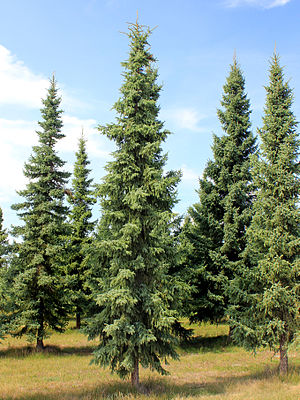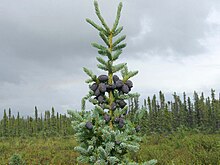Black spruce
| Black spruce | ||||||||||||
|---|---|---|---|---|---|---|---|---|---|---|---|---|

Black spruce ( Picea mariana ) |
||||||||||||
| Systematics | ||||||||||||
|
||||||||||||
| Scientific name | ||||||||||||
| Picea mariana | ||||||||||||
| ( Mill. ) Britt. , EESterns & Poggenburg |
The black spruce ( Picea mariana ) is an evergreen tree from the genus of the spruce ( Picea ) within the pine family (Pinaceae), which is native to northern North America.
description
Habitus
The black spruce grows as an evergreen tree or shrub depending on the site conditions . The tree shape reaches heights of growth of 6 to 35 meters and chest height diameters of about 25 centimeters. The solid trunks are bolt upright. Young trees have a narrow and regularly built crown , the narrow, conical crown of old trees is rather open and irregular. The relatively short and thin branches sit horizontally on the trunks. They are drooping and stand up again at the top. The shrub shape can be found mainly at the tree line. The black spruce grows very slowly, usually only 15 to 25 centimeters per year.
Buds and needles
The egg-shaped buds are light reddish-brown, are about 5 millimeters long and are resin-free. The dense needles are 6 to 18 millimeters long and about 0.8 millimeters wide. They are rectangular in cross-section. The top of the needle is dull green to blue-green. There are one or two rows of whitish stomata on the top and three to four rows of stomata on the underside of the needle . The apex is pointed briefly. The needles are often curved a little inwards from the middle. They are radial on the top of the branch and more or less parted on the underside. The grated needles smell aromatic. They stay on the tree between 5 and 13 years before they fall off.
Flowers, cones and seeds
The black spruce is monoecious, separated from the sexes ( monoecious ) and is capable of self-fertilization. She becomes male at the age of 7 to 10, with mainly female cones being formed up to the age of 14. Later it is the other way around. The flowering period extends from late May to early June. The upright and green to purple-red colored female cones are formed exclusively at the crown tip. The dark red male cones are 12 to 20 millimeters long and are formed on the periphery of the crown. Bisexual inflorescences can develop in the border area of the zones of male and female cones. The initially dark purple later brown cones ripen about three months after flowering. They are between 1.5 and 3.8 inches long and between 1.5 and 1.8 inches thick. The cones consist of rounded to ovoid cone scales. These are stiff, brittle and finely sawn on the edge. The cones sit on a curved stem that is around 2 millimeters long. The seeds are mainly released in spring. Some cones only open when exposed to heat, such as occurs in forest fires, to release the seeds. The light, chocolate-brown seeds are winged and around 2.5 millimeters long without wings. With the wing they are around 10 millimeters long. The tapering seed wing is widest above the middle. The seeds are rarely carried more than 80 meters from the tree. The thousand grain weight is between 1.3 and 1.5 grams. The seedlings possess (2 to 7 cotyledons cotyledons ). The number of chromosomes is 2n = 24.
root
The development of the root system is determined by the nature of the soil. While the tree shape is deep-rooted, the shrub shape has shallow roots. Based on the study of a 130-year-old population in Alaska, it is assumed that the root system accounts for around 15% of the total biomass. The species enters into mycorrhizal partnerships with the hollow foot bolete ( Suillus cavipes ), with the reddish lacquer funnel ( Laccaria laccata ), with Laccaria bicolor , with Pisolithus tinctorius and with species of the genera Cenococcum and Rhizpogon .
bark
The bark of the young shoots is rust-brown and densely hairy, but gradually becomes bald. The bark is dark on older shoots. In the second year they form the first thin bark scales. The scaly bark of the old trees is blackish-gray-brown in color and is rarely thicker than 1.2 centimeters. The inner bark should be olive green to yellow green depending on the source.
Wood
The heartwood is yellowish-white in color and is surrounded by a very narrow and slightly lighter sapwood . The wood is relatively soft. Resin canals are mainly found in latewood . The bulk density is around 0.48 g / cm³. It is higher in the north of the distribution area than in the south. The annual rings are clearly visible.
Distribution and location
The black spruce is native to all of Canada and the northern United States . It is the most common tree species in the Boreal Shield . Their area extends from the east coast of Labrador to the west coast of Alaska . The southern limit of the closed distribution area is in the Great Lakes area , but there are also individual occurrences in New Jersey , Virginia and Pennsylvania . They are found northwards to the polar tree line. It is rarely planted in Europe .
The black spruce is a pioneer species on fire and storm surfaces. It is adapted to extreme climatic and site conditions and also grows on permafrost soils . Even poor, wet, boggy, slightly waterlogged, grassy and frost-prone locations are populated. Optimal locations are calcareous mineral soils, loam and clay soils, as well as moraines and river roads. The pH should be neutral to slightly alkaline. In their natural habitat, the temperature maxima and minima can reach -62 ° C and +41 ° C. Annual precipitation is between 150 and 1,520 mm, a large part of which falls as snow. It occurs from the lowlands to altitudes of 1,800 meters. In the southern part of the distribution area, the species forms mixed forests with Banks pine ( Pinus banksiana ), Weymouths pine ( Pinus strobus ), red alder ( Alnus rubra ), black ash ( Fraxinus nigra ) and the occidental tree of life ( Thuja occidentalis ).
use
The black spruce is one of the most important wood suppliers for paper and pulp production in Canada. There are hardly any sawed goods due to their small dimensions. The wood used to be used as pit wood. The Indians won a binding material from the roots, which they used to make their canoes . The species is also used as a Christmas tree . It is rarely used as an ornamental wood.
Diseases and pests
For the black spruce, forest fires and windthrow pose a greater danger than biotic pests. It is sensitive to hydrogen fluoride . The caterpillars of the moth Choristoneura fumiferana eat the needles and can lead to the death of the plant in the event of severe infestation. The bark beetle Dendroctonus rufipennis is named as a wood pest , which occurs particularly frequently in mixed cultures with the white spruce ( Picea glauca ). The common hallimasch ( Armillaria mellea ), Chrysomyxa ledicola , Chrysomyxa pirolata and Gremmeniella abietina are named among harmful fungi . Snowshoe hares ( Lepus americanus ) bite the branches up to a height of 2 meters.
Systematics
The black spruce is from Schmidt inside the spruce ( Picea ) in the subgenus Picea and the section Picea asked. Welcome assigned the species to the Eupicea section within the spruce trees . The black spruce forms natural hybrids with the white spruce ( Picea glauca ) and the American red spruce ( Picea rubens ). Artificial hybrids with the Serbian spruce ( Picea omorika ), the common spruce ( Picea abies ), the Ajan spruce ( Picea jezoensis ) and the Sitka spruce ( Picea sitchensis ) are also grown.
Synonyms
Synonyms for Picea mariana (Mill.) Britton, Sterns & Poggenb. are: Abies mariana Mill. , Picea brevifolia Peck , Picea mariana var. brevifolia (Peck) Rehder , Picea nigra (Castigl.) Link , Pinus nigra Aiton nom. illeg., Pinus mariana (Mill.) Münchh. Nigricans Weston , Pinus canadensis var .
swell
- Peter Schütt: Picea mariana . In: Peter Schütt, Horst Weisgerber, Hans J. Schuck, Ulla Lang, Bernd Stimm, Andreas Roloff: Lexicon of Conifers. Distribution - Description - Ecology - Use; the great encyclopedia . Nikol, Hamburg 2004, ISBN 3-933203-80-5 , p. 287-296 .
- Christopher J. Earle, Michael P. Frankis: Picea mariana. In: The Gymnosperm Database. January 20, 2011, accessed November 6, 2011 .
Individual evidence
- ↑ Rafaël Govaerts (ed.): Picea. In: World Checklist of Selected Plant Families (WCSP) - The Board of Trustees of the Royal Botanic Gardens, Kew . Retrieved April 14, 2019.
Web links
- Picea mariana in the endangered Red List species the IUCN 2006. Posted by: Conifer Specialist Group, 1998. Retrieved on 12 May, 2006.
- Thomas Meyer: Data sheet with identification key and photos at Flora-de: Flora von Deutschland (old name of the website: Flowers in Swabia )



